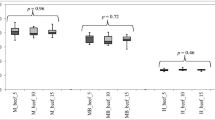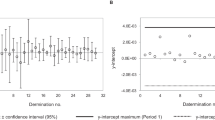Abstract
Sulphiting agents are a class of compounds that are used as preservatives since they release SO2 in food. Regarding meat products, the legislation restricts the use of these food additives, due to some toxic effects that they may have in humans. The most employed analytical procedure for the determination of sulphiting agents in foodstuffs is the Monier-Williams (M-W) method, but the reliability of this method was called into question by several authors. In this work, the M-W method was modified by replacing both the distillation unit to shorten the extraction time (from hours to 5 min) and the final titration with a chromatographic separation followed by conductometric detection of sulphate ion (m-M-W/IC-CD). This method was then validated, and the performance parameters were compared with those of the method based on the direct analysis of sulphite ion by ion chromatography with conductometric detection (DIC-CD). Linearity, accuracy at 40 and 80 mg kg−1 of SO2 and measurement uncertainty resulted comparable. Accuracy at 10 mg kg−1 of SO2 resulted higher for the m-M-W/IC-CD method, but this parameter could be influenced by traces of other sulphur-containing compounds that may be present in meat. The limit of determination of the m-M-W/IC-CD method was slightly higher than that obtained by the DIC-CD method. Finally, through spiking tests, it was proved that sulphide, 2-methyl-3-furanthiol and l-methionine cause “false-positive” responses, by using M-W-based methods.


Similar content being viewed by others
References
Anderson C, Warner C, Daniels D, Padgett K (1986) Ion chromatographic determination of sulfites in foods. J Assoc Off Anal Chem 69(1):14–19
Association of Official Analytical Chemists (2000) Monier-Williams AOAC official method (optimized method) 990.28. AOAC Official Methods of Analysis 29–30
Dainty RH, Edwards RA, Hibbard CM (1989) Spoilage of vacuum-packed beef by a Clostridium sp. J Sci Food Agric 49:473–486
Doulgeraki AI, Ercolini D, Villani F, Nychas GJE (2012) Spoilage microbiota associated to the storage of raw meat in different conditions. Int J Food Microbiol 157:130–141
European Commission (2002) Commission Decision 2002/657/EC of 12 August 2002 implementing Council Directive 96/23/EC concerning the performance of analytical methods and the interpretation of results. Off J Eur Union L221:8–36
European Commission (2004a) Regulation (EC) No 853/2004 of the European Parliament and of the Council of 29 April 2004 laying down specific hygiene rules for on the hygiene of foodstuffs. Off J Eur Union L139:55
European Commission (2004b) Regulation (EC) No 882/2004 of the European Parliament and of the Council of 29 April 2004 on official controls performed to ensure the verification of compliance with feed and food law, animal health and animal welfare rules. Off J Eur Union L165:1–141
European Commission (2011) Commission Regulation (EU) No 1129/2011 amending annex II to Regulation (EC) No 1333/2008 of the European Parliament and of the Council by establishing a union list of food additives. Off J Eur Union L295:1–177
European Commission (2014) Commission Regulation (EU) No 601/2014 of 4 June 2014 amending Annex II to Regulation (EC) No 1333/2008 of the European Parliament and of the Council as regards the food categories of meat and the use of certain food additives in meat preparations. Off J Eur Union L166:11–21
Health Council of the Netherlands, Committee on Updating of Occupational Exposure Limits (2005) Sodium hydrogen sulphite; health-based reassessment of administrative occupational exposure limits. The Hague: Health Council of the Netherlands, 2000/15OSH/157
Huang TC, Ho CT (2012) Flavors and flavor generation of meat products. In: Hui YH (ed) Handbook of meat and meat processing, 2nd edn. CRC Press, Boca Raton, FL, p 110
Hulanicki A, Głab S (1975) Total systematic error in redox titrations with visual indicators—I: basic principles. Talanta 22(4–5):363–370
Hund E, Massart DL, Smeyers-Verbeke J (2001) Operational definitions of uncertainty. TRAC-Trend Anal Chem 20:394–406
Iammarino M, Di Taranto A, Muscarella M, Nardiello D, Palermo C, Centonze D (2010) Development of a new analytical method for the determination of sulphites in fresh meats and shrimps by ion exchange chromatography with conductivity detection. Anal Chim Acta 672:61–65
Iammarino M, Di Taranto A, Muscarella M (2012) Investigation on the presence of sulphites in fresh meat preparations: estimation of an allowable maximum limit. Meat Sci 90(2):304–312
Iida F, Miyazaki Y, Tsuyuki R, Kato K, Egusa A, Ogoshi H, Nishimura T (2016) Changes in taste compounds, breaking properties, and sensory attributes during dry aging of beef from Japanese black cattle. Meat Sci 112:46–51
International Organization for Standardization (2005) ISO/IEC 17025:2005—general requirements for the competence of testing and calibration laboratories. Switzerland, Geneva
Kim BYH, Kempa R, Samuelsson LM (2016) Effects of dry-aging on meat quality attributes and metabolite profiles of beef loins. Meat Sci 111:168–176
Liu X, Gong C, Jiang X (2011) Inhibitory effects of enterococci on the production of hydrogen sulfide by hydrogen sulfide-producing bacteria in raw meat. J Appl Microbiol 111:83–92
Lück E, Jager M (1997) Antimicrobial food additives, characteristics–uses–effects. Springer-Verlag, Berlin Heidelberg
McMeekin TA, Patterson JT (1975) Characterization of hydrogen sulfide-producing bacteria isolated from meat and poultry plants. Appl Microbiol 29(2):165–169
Miller EJC, Miller JN (1993) Statistics for analytical chemistry, 3rd edn. Ellis Horwood PTR Prentice-Hall, West Sussex, p 115
Montes C, Vèlez JH, Ramìrez G, Isaacs M, Arce R, Aguirre MJ (2012) Critical comparison between modified Monier-Williams and electrochemical methods to determine sulfite in aqueous solutions. The Scientific World Jo. http://downloads.hindawi.com/journals/tswj/2012/168148.pdf. Accessed 04 November 2016
New South Wales Food Authority (2009) Preservative use in processed meats—licensee guidance http://www.foodauthority.nsw.gov.au/_Documents/industry/preservative_use_in_processed_meats.pdf. Accessed 04 November 2016
Nordic Committee on Food Analysis (NMKL) (2003) Estimation and expression of measurement uncertainty in chemical analysis, 2nd edn. NMKL Secretariat, Helsinki, procedure No. 5
Przybilla B, Ring J (1987) Sulfite hypersensitivity. Hautarzt 38(8):445–448
Resconi VC, Escudero A, Campo MM (2013) The development of aromas in ruminant meat. Molecules 18:6748–6781
Rochat S, de Saint Laumer JY, Chaintreau A (2007) Analysis of sulfur compounds from the in-oven roast beef aroma by comprehensive two-dimensional gas chromatography. J Chromatogr A 1147:85–94
Ruiz-Capillas C, Jiménez-Colmenero F (2009) Application of flow injection analysis for determining sulphites in food and beverages: a review. Food Chem 112:487–493
Sàdeckà J, Polonsky J (1999) Determination of inorganic ions in food and beverages by capillary electrophoresis. J Chromatogr A 834:401–417
Stanbridge LH, Davies AR (1998) Flavors and flavor generation of meat products. In: Davies A, Board R (eds) Microbiology of meat and poultry. Blackie Academic & Professional, London, p 193
Su YC, Taylor SL (1995) Sulphite analysis of food ingredients: false positive responses with butter flavourings in the optimized Monier-Williams method. Food Addit Contam 12(2):153–160
Sullivan D, Smith R (1985) Determination of sulfite in food by ion chromatography. Food Technol-Chicago 29(7):45–48
Taylor SL, Higley NA, Bush RK (1986) Sulfites in foods: uses, analytical methods, residues, fate, exposure assessment, metabolism, toxicity and hypersensivity. Adv Food Res 30:1–76
United States Department of Agriculture (2006) Determination of sulfites. United States Department of Agriculture Food Safety and Inspection Service, Office of Public Health Science. http://www.fsis.usda.gov/wps/wcm/connect/d5f929bd-8bee-4b4d-be99-dd163c292aa2/CLG_SFT_1_00.pdf?MOD=AJPERES. Accessed 04 November 2016
Vally H, Misso NL, Madan V (2009) Clinical effects of sulphite additives. Clin Exp Allergy 39:1643–1651
Warner CR, Daniels DH, Joe FL Jr, Fazio T (1986) Reevaluation of Monier-Williams method for determining sulphite in food. J Assoc Off Anal Chem 69(1):3–5
Acknowledgements
The authors would like to acknowledge the Istituto Zooprofilattico Sperimentale della Puglia e della Basilicata (Foggia, Italy) for providing financial support and the Italian Ministry of Health (Rome, Italy) for funding the Research Project code GR-2013-02358862.
Author information
Authors and Affiliations
Corresponding author
Ethics declarations
Conflict of Interest
Marco Iammarino declares that he has no conflict of interest. Aurelia Di Taranto declares that she has no conflict of interest. Diego Centonze declares that he has no conflict of interest.
Ethical Approval
This article does not contain any studies with human participants or animals performed by any of the authors.
Informed Consent
Not applicable.
Rights and permissions
About this article
Cite this article
Iammarino, M., Di Taranto, A. & Centonze, D. Determination of Sulphiting Agents in Raw and Processed Meat: Comparison Between a Modified Monier-Williams Method and the Direct Analysis by Ion Chromatography with Conductometric Detection. Food Anal. Methods 10, 3956–3963 (2017). https://doi.org/10.1007/s12161-017-0960-9
Received:
Accepted:
Published:
Issue Date:
DOI: https://doi.org/10.1007/s12161-017-0960-9




